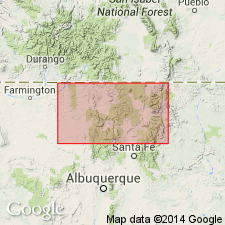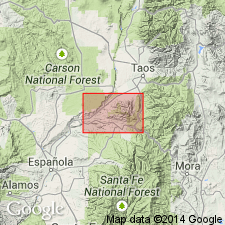
- Usage in publication:
-
- Hopewell series
- Modifications:
-
- Original reference
- Dominant lithology:
-
- Schist
- Basalt
- Andesite
- Quartzite
- AAPG geologic province:
-
- Southern Rocky Mountain region
Summary:
Pg. 10-11, 13 (table 1), 21-22, 42-43, pls. 2, 3. Hopewell series. Succession of metamorphosed igneous flows, with which are interspersed metamorphosed sediments in Picuris and Petaca areas. Flows were principally andesite and basalt (Picuris basalts), most of which are now dark hornblende-chlorite schists. There are some flows of rhyolite and trachyte (Vallecitos rhyolites), most of which are but little changed. Contains some slates and arkosites. In Picuris area, the most conspicuous quartzite is separately mapped as Badito quartzite. In Petaca area, between Tusas and Kiawa Mountains a particularly prominent member is called Cleveland Gulch quartzite. As exposed up to 1.5 miles in thickness, may be considerably thicker. Underlies Ortega quartzite. Age is Precambrian (Proterozoic); are oldest rocks in area.
Type locality not stated. Origin of name not stated, but probably named from town of Hopewell. Mapped in Picuris and Petaca areas between towns of Hopewell on northwest and Picuris on southeast, Rio Arriba and Taos Cos., NM; from Jawbone Mountain to Tusas River, Rio Arriba Co., NM (Petaca area), and also in T. 23 N., R. 10 through 12 E., Taos Co., NM, in Southern Rocky Mountain region.
Source: US geologic names lexicon (USGS Bull. 1200, p. 1801-1802); supplemental information from GNU records (USGS DDS-6; Denver GNULEX).

- Usage in publication:
-
- Hopewell series†
- Modifications:
-
- Abandoned
Summary:
Ortega quartzite of Just (1937) redescribed, revised, and areally extended into report area, Picuris Range area, Taos and Rio Arriba Counties, New Mexico [Southern Rocky Mountain region]. Just (1937) used Ortega for quartzite exposed in Ortega Mountains, 25 miles northwest of Picuris Range. Redescribed in this report as Ortega formation. Consists of wholly metasedimentary rocks (in ascending order): (1) a lower, quartzite member 2,500+ feet thick (base not exposed in this area); (2) Rinconada schist member, which contains 4 mappable units, totaling 1,800 feet: (a) andalusite-biotite hornfels, (b) staurolite gneiss and schist, (c) quartzite, and (d) muscovite-quartz-biotite-garnet phyllite; and (3) Pilar phyllite member (new), a gray-black carbonaceous phyllite, which was called †Hondo slate by Just (1937) [Hondo here abandoned, name preoccupied], 2,300 feet thick. Total thickness of the Ortega formation is 6,600 feet. Unconformably underlies the conglomerate member of Vadito formation (new). Vadito is at least the partial equivalent of †Hopewell series of Just (1937). [Hopewell here abandoned, name preoccupied.] Lithology and distribution described in detail. Age of Ortega formation is pre-Cambrian age. Report includes geologic map, cross sections, columnar section.
Source: Modified from GNU records (USGS DDS-6; Denver GNULEX).
For more information, please contact Nancy Stamm, Geologic Names Committee Secretary.
Asterisk (*) indicates published by U.S. Geological Survey authors.
"No current usage" (†) implies that a name has been abandoned or has fallen into disuse. Former usage and, if known, replacement name given in parentheses ( ).
Slash (/) indicates name conflicts with nomenclatural guidelines (CSN, 1933; ACSN, 1961, 1970; NACSN, 1983, 2005, 2021). May be explained within brackets ([ ]).

